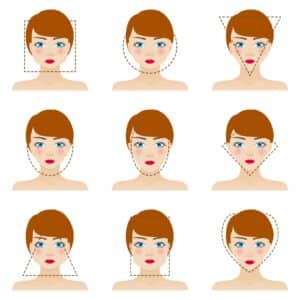Choosing a wig isn’t just about finding the right colour or length; it’s about discovering a style that works with your natural features. One of the most important (and often overlooked) steps in this process is identifying your face shape. The shape of your face plays a huge role in how a wig looks on you, and selecting a wig that suits your proportions can make all the difference when it comes to achieving a natural, balanced, and flattering result.
Whether you’re purchasing a wig for hair loss, fashion, or convenience, and whether it’s a human hair wig or synthetic, understanding how to match the style to your face shape can help you feel confident and comfortable every time you wear it.
Why Face Shape Matters When Choosing a Wig
Everyone’s face is different, and what looks great on one person might not work as well on another. Face shape affects the way hair frames your features, so choosing a wig style that suits your unique proportions can help highlight your best qualities, whether that’s softening a strong jawline, creating more balance, or drawing attention to your eyes and cheekbones. A well-chosen wig should feel like an extension of yourself, not just something you put on.
How to Determine Your Face Shape
Before selecting a wig, it’s helpful to identify your face shape. To do this, pull your hair back and look at the outline of your face in a mirror. You can even trace it with a washable marker or use a photo. Most face shapes fall into one of these categories: oval, round, square, heart, diamond, or long (also called rectangular). Each has its own characteristics, and certain wig styles are better suited to some shapes than others.
Wigs for Oval Face Shapes
If your face is oval-shaped, you’ll notice that your forehead is slightly wider than your chin, with balanced proportions and a gently rounded jawline. This face shape is considered the most versatile, and almost any wig style will suit it. Medium to long styles with layers work particularly well, and both centre and side parts tend to flatter this shape. While you can experiment with various looks, be mindful of styles that hang too heavily over the face, which can hide your natural symmetry rather than enhance it.
Wigs for Round Face Shapes
Round faces are typically characterised by full cheeks, a rounded chin, and a face that’s roughly equal in width and length. When selecting a wig, the goal is to create the illusion of a longer, more structured silhouette. Styles that add height at the crown, such as layered cuts with volume at the top, can elongate the face. Longer wigs that fall below the chin are a great choice, especially when worn with a side part. It’s usually best to avoid short, full styles or curls that sit around the cheek area, as these can make the face appear even rounder.
Wigs for Square Face Shapes
Square face shapes have a strong, defined jawline and a broad forehead. The focus when choosing a wig for this shape is to soften the angular lines and add some roundness. Styles with waves, curls, or textured layers are ideal, as they create movement and reduce the appearance of harsh edges. A side-swept fringe can also work well to soften the forehead. It’s generally a good idea to steer clear of straight, blunt cuts or heavy bangs, as these may accentuate the squareness of the jaw and forehead.
Wigs for Heart-Shaped Faces
Heart-shaped faces are wider at the forehead and taper down to a narrow chin, often with pronounced cheekbones. The key to balancing this shape is adding volume near the jawline while keeping the top section more subdued. Chin-length and shoulder-length styles with soft curls or waves can help draw attention downward and add fullness where it’s needed. Side parts and side fringes are also great for breaking up the width of the forehead. Try to avoid wigs that are too short or full at the crown, as they can emphasise the top-heavy structure of the face.
Wigs for Diamond Face Shapes
A diamond face shape features high, defined cheekbones with a narrow forehead and chin. Wigs that add width to your forehead and jaw area while softening the cheekbones work best. Styles that fall just past the shoulders, especially those with gentle waves and textured layers, can provide a balanced look. Side-swept fringes can help broaden the appearance of the forehead. Avoid styles that tuck tightly behind the ears or pull the hair back too severely, as these can draw more attention to the widest part of the face.
Wigs for Long or Rectangular Face Shapes
Long or rectangular faces are longer than they are wide and may have a straight cheek line and a higher forehead. The aim here is to reduce the appearance of length and bring balance by adding volume around the sides of the face. Shoulder-length styles with waves or curls are often a great choice, as are wigs with a fringe to visually shorten the forehead. Chin-length bobs can also help add width and soften the overall shape. It’s usually best to avoid extra-long wigs or styles with height at the crown, which can make the face appear even longer.
Other Factors to Consider When Choosing a Wig
Face shape is a strong starting point, but it’s only one part of the equation. The type of wig or hairpiece you choose also plays a significant role in determining how natural it looks, how it feels to wear, and the level of maintenance it requires. There are several options available, each with its own benefits depending on your needs, lifestyle, and budget.
Human hair wigs
Human hair wigs are widely considered the most realistic and versatile option. They can be cut, coloured, curled, or straightened just like natural hair, and they tend to last longer than synthetic wigs with proper care. They’re ideal for everyday wear or for anyone looking for a high-quality, customisable solution that mimics natural hair movement and texture. Because they’re made from real hair, they typically come with a higher price tag but offer unmatched flexibility and longevity.
Synthetic wigs
Synthetic wigs have come a long way in recent years and can be a more affordable option. They often come pre-styled, meaning they hold their shape even after washing, which is great for convenience. However, synthetic fibres can’t be heat-styled unless specified as heat-resistant, and they generally don’t last as long as human hair wigs. Still, for occasional wear or for those who want a low-maintenance option, they’re a popular and practical choice.
Hair Toppers
For those dealing with partial hair loss or thinning in specific areas, hair toppers can be a fantastic solution. These are designed to clip or blend into your existing hair, adding volume and coverage where you need it most, commonly at the crown, part line, or sides. Toppers come in a range of base sizes, styles, and hair types, and can be customised to match your natural hair.
Skin Hair Patches
Skin hair patches are another option, particularly for people experiencing hair loss in more defined areas such as the hairline, temples, or crown. These ultra-realistic patches are designed to mimic the appearance of hair growing directly from the scalp. They’re often used with medical-grade adhesive for a seamless, undetectable finish, making them ideal for people with alopecia, scarring, or patchy hair loss.
At The End Of The Day
If you don’t need full coverage, hairpieces and clip-in hair toppers can also be used to add volume, length, or highlights to your natural hair without committing to a full wig. These are a great option for styling flexibility and for special occasions when you want a quick boost in your look.
When choosing any type of wig or hair addition, it’s important to think about your daily routine, how often you plan to wear it, and whether you’ll be styling it with heat tools. Your lifestyle, hair loss pattern, and comfort level should all factor into your final decision. A well-fitted and properly chosen wig or hairpiece should not only suit your face shape, it should also suit you.
Interested in how to choose the best sunscreen for your skin, too? Read our article here:
Glow Up This Spring: 10 Powerful Sunscreens to Save Your Skin













